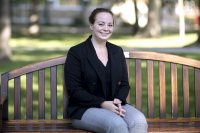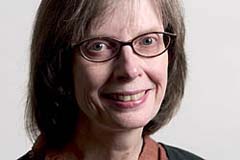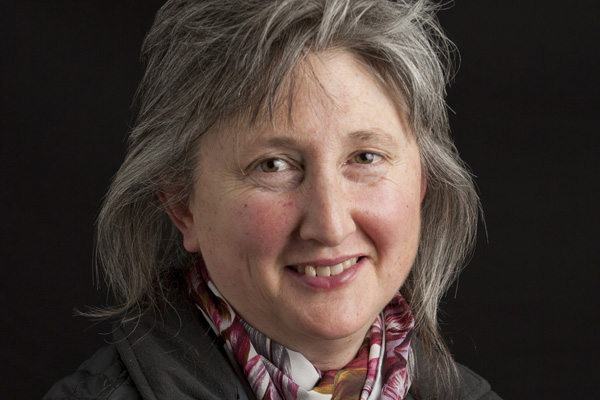
John A. Tagliabue memorial minute
The traditional memorial minute was read at the Sept. 11, 2006, faculty meeting by Professor of English Carole Anne Taylor for the late Professor Emeritus of English John A.Tagliabue.
Fellow English faculty member Rob Farnsworth read his own poem in memory of Tagliabue as well as one of the late poet’s own poems.
For John Tagliabue, who devoted 36 years to Bates as teacher, colleague, friend, raconteur and poet laureate, neither a memorial minute, nor even two voices, begins to suffice. Everyone who knew him has their favorite John stories, inadequately represented here. But we hope you’ll indulge us in rather more than a minute and remember this renowned American poet by reading his poems again or for the first time.
John was born in Cantu, Italy, in 1923, to a restauranteur father who encouraged John to dance for customers and a mother whose wit as a storyteller, even in advanced age in Lewiston, helped to explain the phenomenon of John. He received a B.A. and an M.A. from Columbia University, where he became a lifelong friend of Allen Ginsberg and knew such countercultural icons as William Burroughs and Jack Kerouac.
But John preferred celebration even then, hung out with dancers, and, in 1946, married his life-partner Grace, a visual artist and fellow visionary whose glad kindness, it did not take a poet to recognize, warrants her name. He would teach in Beirut and several other places before coming to Bates in 1953, at a time when he was expected to get President Charles Phillips’ approval for any poems that he read or published. During the McCarthy era, at a time when faculty of color were few and far between and gay faculty knew that to be outed would mean summary dismissal, no doubt John’s and Grace’s support of civil rights, gay rights and the anti-war and anti-nuclear movements seemed to some dubious engagements. But with extraordinary charm to assist him, John negotiated this terrain by enriching and subverting simultaneously, with such liberatory and allusive poetic reference that a censor never stood a chance.
By the time I arrived in the late ’70s, his merged poetic and institutional personae had become so artful that I would have to learn that his studiously ethereal persona disguised a selective but extremely well-organized competence. (He wrote: “Does any one mail more mail than I do” / I don’t think so: not even Sears Roebuck, / not even seals spouting on their way to one / of their favorite really pleasurable resorts do….”) His colleague of the time Bud Rovett tells a story of walking across the Quad with John and running into President Phillips, for whom John performed a spontaneously hyperbolic encomium to the spring, the birds and the character of infinite wonder until the President managed his formal departure and John turned to his friend and said, “Well, no more committees for another year.”
And yet, on his own terms, he gave unstintingly generous gifts to the College. Among Bates’s many wonderful teachers, probably no one has been more often invoked or remembered as legendary while still alive, and nobody could match John for how well he kept in touch with former students all over the world. John’s pedagogy, which relied on inspired preparation, involved arriving early to cover the blackboard with brilliantly diverse and relevant quotations, the excitement of crosscultural connections in graphic juxtaposition. Becoming what he was doing, he would arrive in black to teach Hamlet or in a bright multicolored striped sweater to talk about Shakespearean fools. An avid and perceptive world traveler who had six Fulbrights, he taught in Greece, Spain, Brazil, Italy, Japan and the People’s Republic of China; and at Bates, he was the first to teach Asian and other world literatures beyond the European. And, of course, he acted as the first mentor for many who became littérateurs in their own right. He saw his task clearly: to foster a love of literature so intense that it would last his students’ lifetimes. Appropriately, they found him “Buddhaesque,” full of spiritually informed laughter and wisdom (my son was sure that whoever designed Yoda must have known John first). And abundant testimony suggests that he never failed to enact what he taught in a pedagogy at once lyrical, dramatic and utopian in its energies.
I’ll offer here just a couple of comments from a memorial Web site started by Richard Carlson that also includes some of John’s last poems and correspondence, and hope it will suggest the character of his effect on students. John Holt wrote: “He was the Sage of Lewiston and the light that woke us up…. He was the Buddha Uproar at dawn on Mount David, masked dancer, Dionysian spirit, Vishnu by the Androscoggin.” And Diane Davies speaks for many: “…the world needs to hear more of his work. Those of us who knew and loved him were very lucky indeed. It is shocking, like he used to say the death of Mercutio was shocking, to see so much vitality snuffed out forever. So that he may not wholly die then, do what you can to keep his poetry alive.”
As colleague, that vitality brought us all daily delight. John’s early rounds made poems appear on our doors before we arrived, often geared specifically to us. If you’d given him a weird-shaped potato from your garden, say, by the following day it might become the Willendorf Venus making out with Wittgenstein. He involved us in the annual United Nations of Poetry in his living room, where students and teachers alike brought and read poetry across the cultures, as well as in such rich imaginative productions as the fantastical Mario Puppet Plays. Always the singer of praise songs for humble moments or great thinkers, he treated literary, cultural discussions with anyone as worthy of the highest seriousness. And since he celebrated his colleagues, friends and students with the same effusive glee that springs from his poems (indeed, often in the poems), he made us all want to live up to such high description.
The first four volumes of poetry — Poems (1950); A Japanese Journal (1966); The Buddha Uproar (1970); and The Doorless Door (1970) — preceded two later collections ranging over many years, The Great Day: Poems, 1962-1983, and New and Selected Poems: 1942-1997. Those lauding John as a poet read like a Who’s Who in American poetry, including Gwendolyn Brooks (“a shrewd candor that includes beauty, music and an exciting energy”); Hayden Carruth (“a thread of sanity in the general murk, a constant music”); John Ciardi (“like common daylight curuscating through a prism”); Amy Clampit (“a Franciscan act of courtesy and praise”); Denise Levertov (“profuse and various, combin[ing] innocence and knowledge in an unique way”); and X.J. Kennedy, who called him “the Shelleyan colossus of the North.” Locally, John mined the Bates world for lyrical incentives and always surprised, from “Highest Honors; coolness breeze” to my favorite, the poem called “To Dedicate a Library,” read on the inauguration of Ladd Library. Several talk of reviving the puppet plays, and you may now see some of Grace’s miraculous puppets on display in Ladd. John’s poetic stature continues to grow, and Syracuse University has archived his notebooks, journals and correspondence.
When poets came to visit, John frequently introduced them with a praise-poem of his own, so it’s most fitting that Rob perform that function here. But because John was so fond of the luminous detail, I want to end with a personal image of John, who, although Grace grew gorgeous flowers, was in much too intimate communion with nature to own a lawnmower. Nevertheless, when a neighbor mentioned that John’s unkempt grass was spilling through the fence, he took Grace’s largest scissors and plopped himself down in sundry spots to cut concentric circles around himself, producing a temple-like configuration of these stunningly mystical donuts. So we, too, should “weave a circle around him thrice” (Kubla Khan), because he has “drunk the milk of paradise,” and be grateful, in his words, that:
moment by moment we were
granted all this
verbal eternity.




